Setting time Citroen GRAND C4 PICASSO 2017 2.G User Guide
[x] Cancel search | Manufacturer: CITROEN, Model Year: 2017, Model line: GRAND C4 PICASSO, Model: Citroen GRAND C4 PICASSO 2017 2.GPages: 527, PDF Size: 12.91 MB
Page 165 of 527
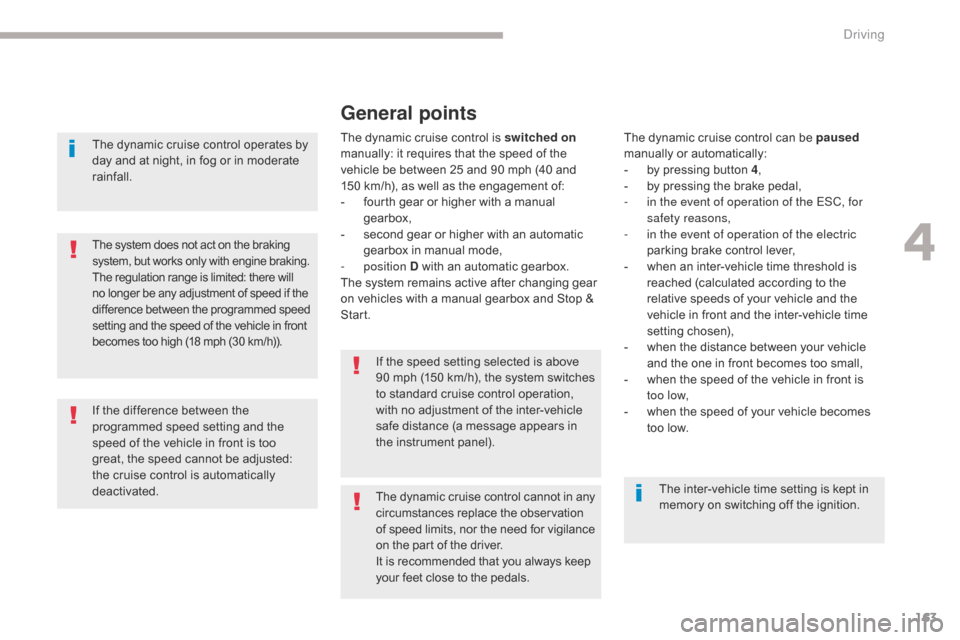
163
C4-Picasso-II_en_Chap04_conduite_ed02-2016
The dynamic cruise control is switched on
manually: it requires that the speed of the
vehicle be between 25 and 90 mph (40 and
150
km/h), as well as the engagement of:
-
f
ourth gear or higher with a manual
gearbox,
-
s
econd gear or higher with an automatic
gearbox in manual mode,
-
position D with an automatic gearbox.
The system remains active after changing gear
on vehicles with a manual gearbox and Stop &
Start.
General points
The dynamic cruise control can be paused
manually or automatically:
-
b
y pressing button 4 ,
-
b
y pressing the brake pedal,
-
i
n the event of operation of the ESC, for
safety reasons,
-
i
n the event of operation of the electric
parking brake control lever,
-
w
hen an inter-vehicle time threshold is
reached (calculated according to the
relative speeds of your vehicle and the
vehicle in front and the inter-vehicle time
setting chosen),
-
w
hen the distance between your vehicle
and the one in front becomes too small,
-
w
hen the speed of the vehicle in front is
too
low,
-
w
hen the speed of your vehicle becomes
too low.
The dynamic cruise control cannot in any
circumstances replace the observation
of speed limits, nor the need for vigilance
on the part of the driver.
It is recommended that you always keep
your feet close to the pedals. If the speed setting selected is above
90 mph (150 km/h), the system switches
to standard cruise control operation,
with no adjustment of the inter-vehicle
safe distance (a message appears in
the instrument panel). The inter-vehicle time setting is kept in
memory on switching off the ignition.
The dynamic cruise control operates by
day and at night, in fog or in moderate
rainfall.
The system does not act on the braking
system, but works only with engine braking.
The regulation range is limited: there will
no longer be any adjustment of speed if the
difference between the programmed speed
setting and the speed of the vehicle in front
becomes too high (18 mph (30 km/h)).
If the difference between the
programmed speed setting and the
speed of the vehicle in front is too
great, the speed cannot be adjusted:
the cruise control is automatically
deactivated.
4
Driving
Page 166 of 527
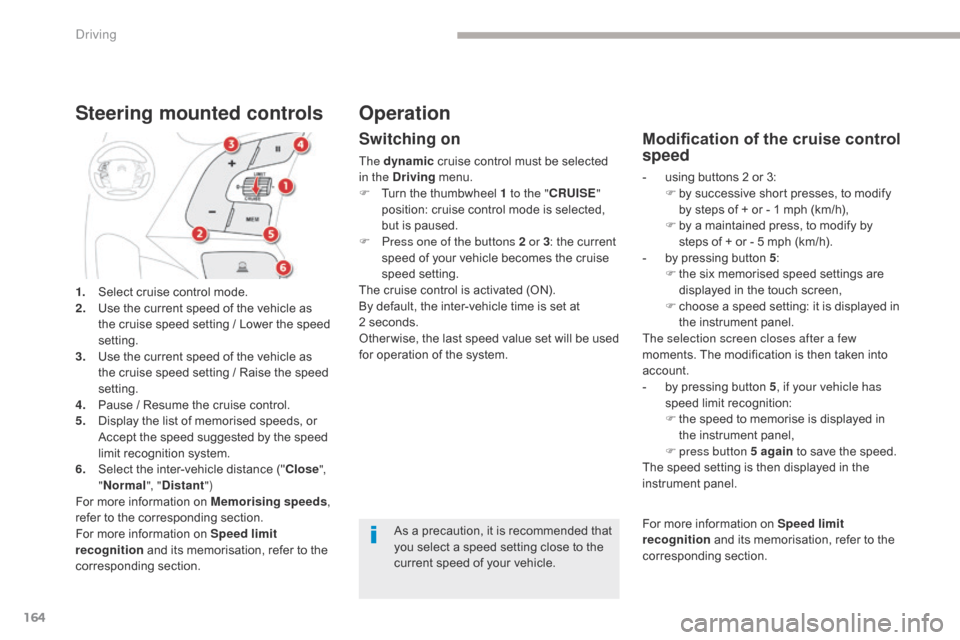
164
C4-Picasso-II_en_Chap04_conduite_ed02-2016
1. Select cruise control mode.
2. Use the current speed of the vehicle as
the cruise speed setting / Lower the speed
setting.
3.
U
se the current speed of the vehicle as
the cruise speed setting / Raise the speed
setting.
4.
P
ause / Resume the cruise control.
5.
D
isplay the list of memorised speeds, or
A
ccept the speed suggested by the speed
limit recognition system.
6.
S
elect the inter-vehicle distance (" Close",
" Normal ", "Distant ")
For more information on Memorising speeds ,
refer to the corresponding section.
For more information on Speed limit
recognition and its memorisation, refer to the
corresponding section.
Steering mounted controls
Switching on
The dynamic cruise control must be selected
in the Driving menu.
F
T
urn the thumbwheel 1 to the " CRUISE"
position: cruise control mode is selected,
but is paused.
F
P
ress one of the buttons 2 or 3 : the current
speed of your vehicle becomes the cruise
speed setting.
The cruise control is activated (ON).
By default, the inter-vehicle time is set at
2
seconds.
Other wise, the last speed value set will be used
for operation of the system.
Modification of the cruise control
speed
- using buttons 2 or 3: F b y successive short presses, to modify
by steps of + or - 1 mph (km/h),
F
b
y a maintained press, to modify by
steps of + or - 5 mph (km/h).
-
b
y pressing button 5 :
F
t
he six memorised speed settings are
displayed in the touch screen,
F
c
hoose a speed setting: it is displayed in
the instrument panel.
The selection screen closes after a few
moments. The modification is then taken into
account.
-
b
y pressing button 5 , if your vehicle has
speed limit recognition:
F
t
he speed to memorise is displayed in
the instrument panel,
F
press button 5 again to save the speed.
The speed setting is then displayed in the
instrument panel.
As a precaution, it is recommended that
you select a speed setting close to the
current speed of your vehicle.
Operation
For more information on Speed limit
recognition and its memorisation, refer to the
corresponding section.
Driving
Page 168 of 527
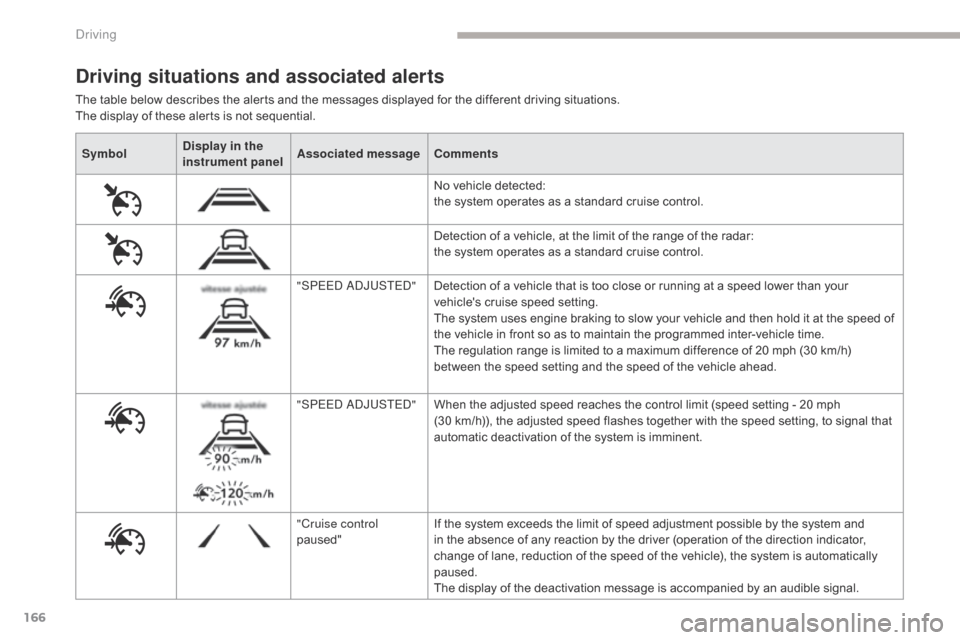
166
C4-Picasso-II_en_Chap04_conduite_ed02-2016
SymbolDisplay in the
instrument panel Associated message
Comments
No vehicle detected:
the system operates as a standard cruise control.
Detection of a vehicle, at the limit of the range of the radar:
the system operates as a standard cruise control.
"SPEED ADJUSTED" Detection of a vehicle that is too close or running at a speed lower than your
vehicle's cruise speed setting.
The system uses engine braking to slow your vehicle and then hold it at the speed of
the vehicle in front so as to maintain the programmed inter-vehicle time.
The regulation range is limited to a maximum difference of 20 mph (30 km/h)
between the speed setting and the speed of the vehicle ahead.
"SPEED ADJUSTED" When the adjusted speed reaches the control limit (speed setting - 20 mph
(30
km/h)), the adjusted speed flashes together with the speed setting, to signal that
automatic deactivation of the system is imminent.
"Cruise control
paused" If the system exceeds the limit of speed adjustment possible by the system and
in the absence of any reaction by the driver (operation of the direction indicator,
change of lane, reduction of the speed of the vehicle), the system is automatically
paused.
The display of the deactivation message is accompanied by an audible signal.
Driving situations and associated alerts
The table below describes the alerts and the messages displayed for the different driving situations.
The display of these alerts is not sequential.
Driving
Page 192 of 527

190
C4-Picasso-II_en_Chap04_conduite_ed02-2016
Fatigue detection system
It is recommended that you take a break as soon as you feel tired or at least every two hours.
Depending on version, the function either has the "Driving time warning" only, or this combined with the "Fatigue detection system".
Driving time warning
The system triggers an alert once it detects that
the driver has not taken a break after two hours
of driving at a speed above 40 mph (65 km/h).
This alert takes the form of the display of a
message encouraging you to take a break,
accompanied by an audible signal.
If the driver does not follow this advice, the
alert is repeated hourly until the vehicle is
stopped.
The system cannot in any
circumstances replace the need for
vigilance on the part of the driver.
Do not take the wheel if you are tired.
As soon as the speed of the vehicle
drops below 40 mph (65 km/h), the
system goes into standby.
The driving time is counted again once
the speed is above 40 mph (65 km/h).
The system resets itself if one of the following
conditions is met:
-
e
ngine running, the vehicle has been
stationary for more than 15 minutes,
-
t
he ignition has been switched off for a
few
m
inutes,
-
t
he driver's seat belt is unfastened and
their door is open.
The system is activated or deactivated in the
touch screen tablet.
Activation / Deactivation
In the Driving
menu, select the " Vehicle
settings " tab, then " Security" and "Fatigue
Detection System ".
Driving
Page 213 of 527
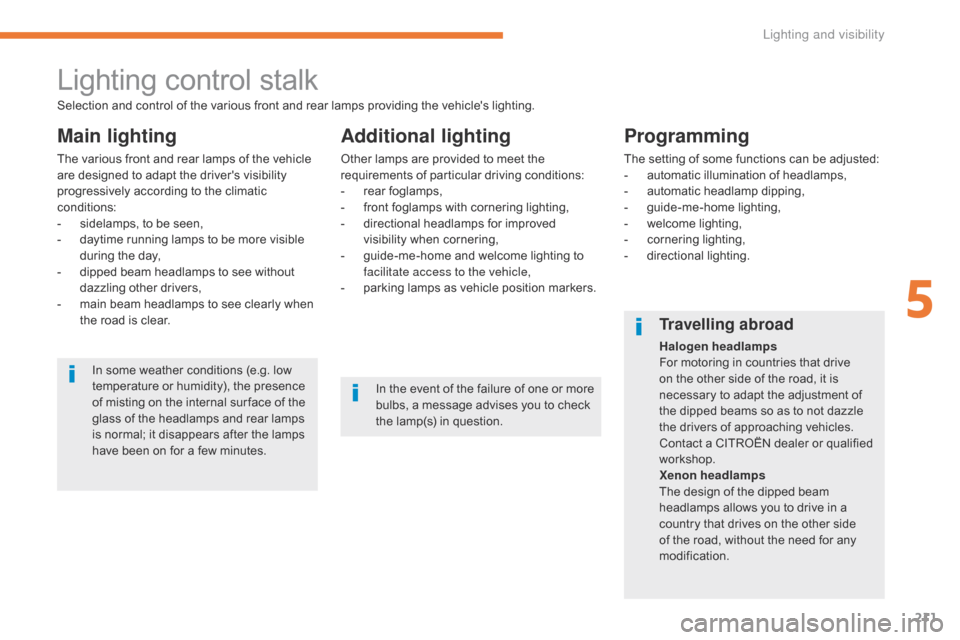
211
C4-Picasso-II_en_Chap05_eclairage-visibilite_ed02-2016
Lighting control stalk
Main lighting
The various front and rear lamps of the vehicle
are designed to adapt the driver's visibility
progressively according to the climatic
conditions:
-
s
idelamps, to be seen,
-
d
aytime running lamps to be more visible
during the day,
-
d
ipped beam headlamps to see without
dazzling other drivers,
-
m
ain beam headlamps to see clearly when
the road is clear.
Additional lighting
Other lamps are provided to meet the
requirements of particular driving conditions:
-
r
ear foglamps,
-
f
ront foglamps with cornering lighting,
-
d
irectional headlamps for improved
visibility when cornering,
-
g
uide-me-home and welcome lighting to
facilitate access to the vehicle,
-
p
arking lamps as vehicle position markers.
Programming
The setting of some functions can be adjusted:
- a utomatic illumination of headlamps,
-
a
utomatic headlamp dipping,
-
g
uide-me-home lighting,
-
w
elcome lighting,
-
c
ornering lighting,
-
d
irectional lighting.
In some weather conditions (e.g. low
temperature or humidity), the presence
of misting on the internal sur face of the
glass of the headlamps and rear lamps
is normal; it disappears after the lamps
have been on for a few minutes.
Travelling abroad
Halogen headlamps
For motoring in countries that drive
on the other side of the road, it is
necessary to adapt the adjustment of
the dipped beams so as to not dazzle
the drivers of approaching vehicles.
Contact a CITROËN dealer or qualified
workshop.
Xenon headlamps
The design of the dipped beam
headlamps allows you to drive in a
country that drives on the other side
of the road, without the need for any
modification.
In the event of the failure of one or more
bulbs, a message advises you to check
the lamp(s) in question.
Selection and control of the various front and rear lamps providing the vehicle's lighting.
5
Lighting and visibility
Page 222 of 527
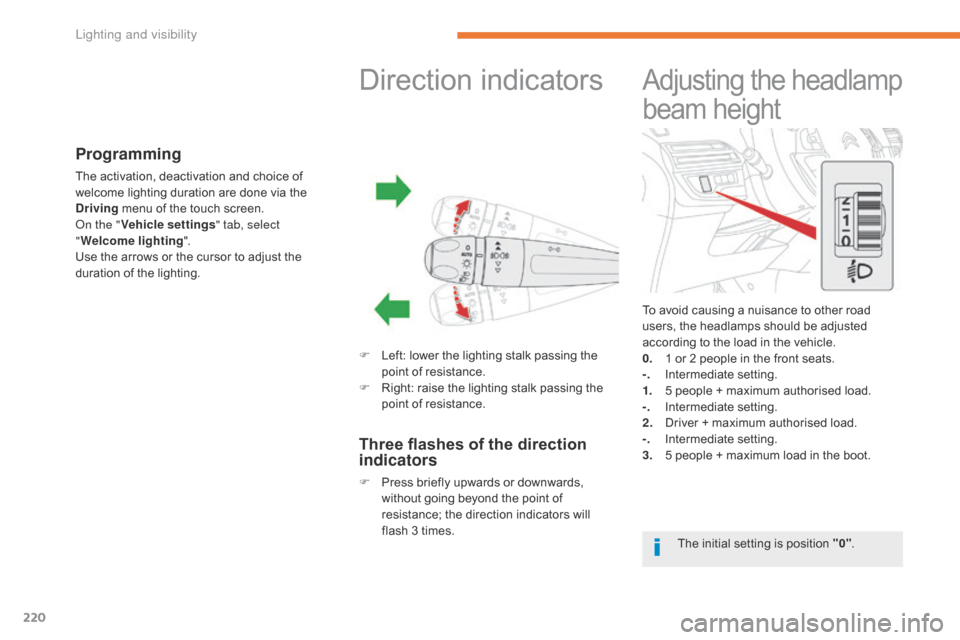
220
C4-Picasso-II_en_Chap05_eclairage-visibilite_ed02-2016
To avoid causing a nuisance to other road
users, the headlamps should be adjusted
according to the load in the vehicle.
0.
1 o
r 2 people in the front seats.
-.
I
ntermediate setting.
1.
5 p
eople + maximum authorised load.
-.
I
ntermediate setting.
2.
D
river + maximum authorised load.
-.
I
ntermediate setting.
3.
5 p
eople + maximum load in the boot.
Adjusting the headlamp
beam height
The initial setting is position "0" .
Programming
The activation, deactivation and choice of
welcome lighting duration are done via the
Driving menu of the touch screen.
On the " Vehicle settings " tab, select
" Welcome lighting ".
Use the arrows or the cursor to adjust the
duration of the lighting.
Direction indicators
F Left: lower the lighting stalk passing the point of resistance.
F
R
ight: raise the lighting stalk passing the
point of resistance.
Three flashes of the direction
indicators
F Press briefly upwards or downwards, without going beyond the point of
resistance; the direction indicators will
flash 3 times.
Lighting and visibility
Page 338 of 527
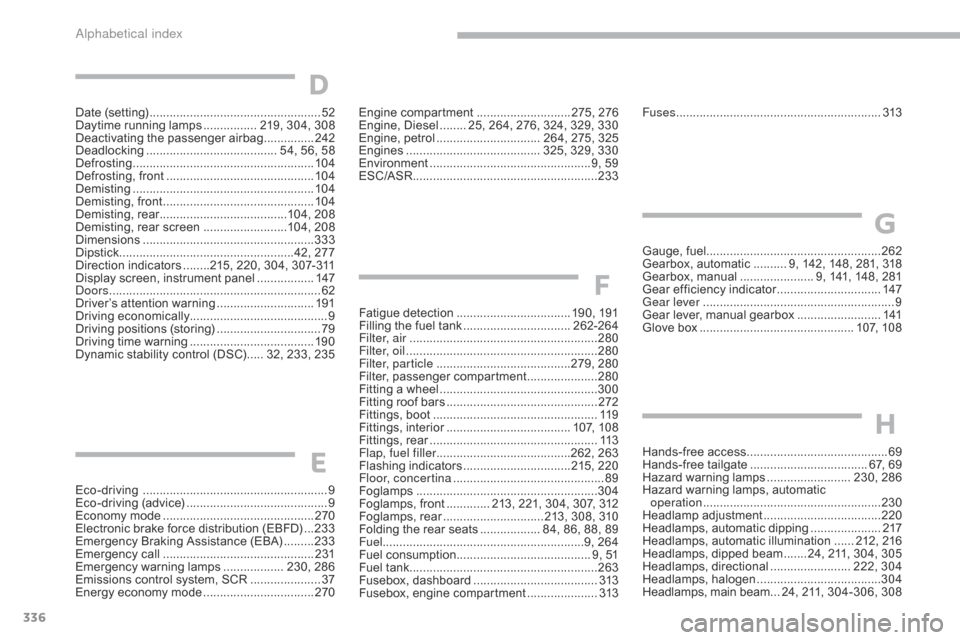
336
C4-Picasso-II_en_Chap10_index-alpha_ed02-2016
Hands-free access ..........................................69
H ands-free tailgate ................................... 6 7, 69
Hazard warning lamps
......................... 2
30, 286
Hazard warning lamps, automatic operation
...............................
......................230
He
adlamp adjustment
................................... 2
20
Headlamps, automatic dipping
.....................2
17
Headlamps, automatic illumination
......21
2, 216
Headlamps, dipped beam
....... 2
4, 211, 304, 305
Headlamps, directional
........................ 2
22, 304
Headlamps, halogen
..................................... 3
04
Headlamps, main beam
... 2
4, 211, 304-306, 308
H
Date (setting) ............................... ....................52
Daytime running lamps ................ 2 19, 304, 308
Deactivating the passenger airbag
............... 2
42
Deadlocking
...............................
........ 54, 56, 58
Defrosting
...............................
.......................104
Defrosting, front
............................................ 10
4
Demisting
...............................
.......................104
Demisting, front
............................................. 10
4
Demisting, rear
......................................1
04, 208
Demisting, rear screen
.........................1
04, 208
Dimensions
..............................
.....................333
Dipstick
................
....................................42, 277
Direction indicators
........2
15, 220, 304, 307-311
Display screen, instrument panel
.................14
7
Doors
..............................................................
.62
Driver’s attention warning
.............................19
1
Driving economically ......................................... 9
Driving positions (storing)
...............................79
D
riving time warning
..................................... 19
0
Dynamic stability control (DSC)
..... 3
2, 233, 235
Eco-driving
...............................
........................ 9
Eco-driving (advice)
.......................................... 9
E
conomy mode
...............................
..............270
Electronic brake force distribution (EBFD)
...23
3
Emergency Braking Assistance (EBA)
.........23
3
Emergency call
............................................. 2
31
Emergency warning lamps
.................. 2
30, 286
Emissions control system, SCR
.....................37
E
nergy economy mode
.................................2
70
F
D
Fatigue detection ..................................19 0, 191
Filling the fuel tank ................................ 26
2-264
Filter, air
...............
......................................... 280
Filter, oil
......................................................... 28
0
Filter, particle
........................................2
79, 280
Filter, passenger compartment
..................... 28
0
Fitting a wheel
...............................
................300
Fitting roof bars
............................................. 2
72
Fittings, boot
................................................. 11
9
Fittings, interior
..................................... 10
7, 108
Fittings, rear
...............................
...................113
Flap, fuel filler
...............................
.........262, 263
Flashing indicators
................................2
15, 220
Floor, concertina
............................................. 89
F
oglamps
..............................
........................304
Foglamps, front
............. 2
13, 221, 304, 307, 312
Foglamps, rear
.............................. 2
13, 308, 310
Folding the rear seats
.................. 8
4, 86, 88, 89
Fuel ............................................................9, 264
Fuel consumption
........................................ 9
, 51
Fuel tank........................................................ 263
Fusebox, dashboard
..................................... 3
13
Fusebox, engine compartment
..................... 3
13
E
Engine compartment ............................ 275, 276
Engine, Diesel ........ 2 5, 264, 276, 324, 329, 330
Engine, petrol
............................... 2
64, 275, 325
Engines
..............................
.......... 325, 329, 330
Environment
...............................
.................9, 59
ESC/ASR
...............................
........................233Fuses ................
.............................................
313
Gauge, fuel.................................................... 262
Gearbox, automatic
.......... 9
, 142, 148, 281, 318
Gearbox, manual
...................... 9
, 141, 148, 281
Gear efficiency indicator
...............................14
7
Gear lever
..............................
........................... 9
Gear lever, manual gearbox
.........................1
41
Glove box
..............................................10
7, 108
G
Alphabetical index
Page 340 of 527

338
C4-Picasso-II_en_Chap10_index-alpha_ed02-2016
Net .................................................................120
Number plate lamps ...................................... 3
12
Safety, children
....................2
42, 245, 246, 250,
252, 255, 256, 258, 260
Scented air freshener
...................................10
5
Screen, cold climate
.....................................26
6
Screenwash, front
......................................... 2
25
Screenwash, rear
...............................
...........224
SCR (Selective Catalytic Reduction) system
................
.........................................282
Seat belts
......................2
36, 237, 239, 240, 251
Seats, electric
................................................. 78
Se
ats, front
...............................
...........76, 78, 79
Seats, heated
...............................
...................82
Seats, rear
.................................... 8
4, 86, 88, 89
Selector, gear
................................................ 14
2
Serial number, vehicle
..................................33
4
Service indicator
............................................. 38
S
ervicing
...............................
............................ 9
Settings, equipment
.................................. 1
1, 13
Range
................
..............................................51
Range, AdBlue
® ............................... ...............43
Reading lamps, rear ...................................... 11
3
Rear screen, demisting
................................. 10
4
Recharging the battery
................................. 32
0
Recirculation, air
...............................
........96, 99
Reduction of electrical load
.......................... 2
70
Regeneration of the particle filter
.................28
0
Reinitialisation of the under-inflation detection system
......................................... 20
6
Reinitialising the remote control
.....................59
R
emote control
.................................... 5
3 -57, 60
Removing a wheel
..............................
..........300
Removing the mat
...............................
..........112
Pads, brake
...................................................
2
81
Paint colour code
.......................................... 33
4
Oil change
...............................
......................
277
Oil consumption
............................................
2
77
OIl, engine
...............................
......................
277
Opening the bonnet
......................................
2
74
Opening the boot
..............................
. 53, 55, 64
Opening the doors
...............................
.....53, 55
Opening the panoramic sunroof blind
.......... 2
28 Panoramic glass sunroof
..............................
2
28
Parcel shelf, rear
................................... 11
3 , 118
Park Assist
............................ 1
97, 199, 201, 202
Parking brake
................................................
2
81
Parking brake, electric
..........................
13
3, 13 8
Parking sensors, front
...................................
19
3
Parking sensors, rear.................................... 192
Plates, identification ...................................... 334
Port, USB
......................................................
111
P
ressures, tyres
................... 2
88, 293, 303, 334
Pre-tensioning seat belts
..............................
24
0
Priming pump
...............................
.................
324
Priming the fuel system
................................
3
24
Protecting children
....................... 2
42, 245, 246,
250, 252, 255, 256, 258, 260
Puncture
................
........................287, 294, 296
N
S
R
P
O
Mountings, Isofix ...............................
............254
Multimedia, rear ............................... .............115 Replacing bulbs ............................
3 04, 308-311
Replacing fuses .............................. ..............313
Replacing the air filter
...................................28
0
Replacing the oil filter
...................................28
0
Replacing the passenger compartment
filter
........
.....................................................280
Resetting the service indicator
.......................40
R
esetting the trip recorder
..............................46
R
eversing camera
...............................
..........19 4
Reversing lamp
..................................... 3
08-311
Roof bars
....................................................... 2
72
Running out of fuel (Diesel)
..........................3
24
Alphabetical index
Page 341 of 527
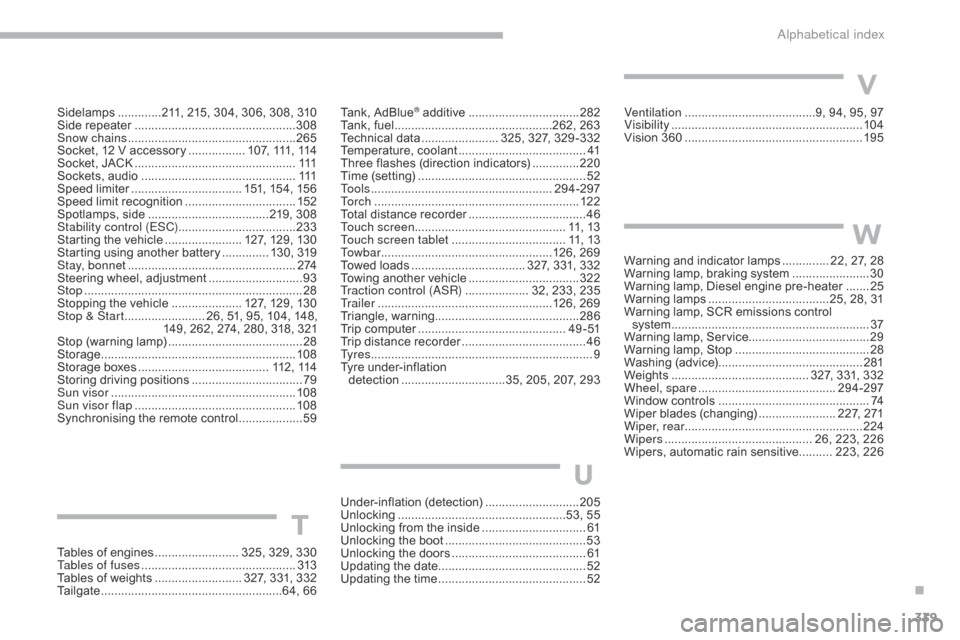
339
C4-Picasso-II_en_Chap10_index-alpha_ed02-2016
Sidelamps .............211, 215, 304, 306, 308, 310
Side repeater .............................. ..................308
Snow chains
.................................................. 26
5
Socket, 12 V accessory
................. 1
07, 111, 114
Socket, JACK
...............................
.................111
Sockets, audio
.............................................. 111
Spe
ed limiter
...............................
.. 151, 154, 156
Speed limit recognition
................................. 15
2
Spotlamps, side
....................................2
19, 308
Stability control (ESC) ...................................233
Starting the vehicle
....................... 1
27, 129, 130
Starting using another battery
.............. 1
30, 319
Stay, bonnet
...............................
...................2 74
Steering wheel, adjustment
............................93
St
op
...............
.................................................. 28
Stopping the vehicle
..................... 1
27, 129, 130
Stop & Start
........................ 2
6, 51, 95, 104, 148,
149, 262, 274, 280, 318, 321
Stop (warning lamp)
........................................ 28
St
orage
................
.......................................... 108
Storage boxes
....................................... 11
2 , 114
Storing driving positions
.................................79
S
un visor
....................................................... 10
8
Sun visor flap
...............................
.................108
Synchronising the remote control
...................59
T
Tables of engines ......................... 3 25, 329, 330
Tables of fuses .............................................. 3
13
Tables of weights
.......................... 3
27, 331, 332
Tailgate
................
......................................64, 66
W
V
Warning and indicator lamps .............. 2 2, 27, 28
Warning lamp, braking system .......................3
0
Warning lamp, Diesel engine pre-heater
.......25
W
arning lamps
....................................2
5, 28, 31
Warning lamp, SCR emissions control system
................
........................................... 37
Warning lamp, Service.................................... 29
Warning lamp, Stop
........................................ 28
W
ashing (advice) ........................................... 281
Weights
...............
.......................... 327, 331, 332
Wheel, spare
......................................... 29
4-297
Window controls
............................................. 74
W
iper blades (changing)
....................... 2
27, 271
Wiper, rear ..................................................... 224
Wipers
............................................ 2
6, 223, 226
Wipers, automatic rain sensitive
.......... 2
23, 226
Under-inflation (detection)
............................ 20
5
Unlocking
..............................
....................53, 55
Unlocking from the inside
............................... 61
U
nlocking the boot
.......................................... 53
U
nlocking the doors
........................................ 61
U
pdating the date
............................................ 52
U
pdating the time
............................................ 52
U
Tank, AdBlue® additive .................................28 2
Tank, fuel
............................... ................262, 263
Technical data
....................... 325
, 327, 329-332
Temperature, coolant
...................................... 41
T
hree flashes (direction indicators)
..............2
20
Time (setting)
..............................
....................52
To o l s
................
...................................... 294-297
To r c h
..............................
............................... 12 2
Total distance recorder
................................... 46
T
ouch screen ............................................. 11, 13
Touch screen tablet
.................................. 1
1, 13
To w b a r
................
...................................126, 269
Towed loads
.................................. 3
27, 331, 332
Towing another vehicle
................................. 32
2
Traction control (ASR)
................... 3
2, 233, 235
Tr a i l e r
...............
.....................................126, 269
Triangle, warning ........................................... 286
Trip computer
............................................ 4
9 - 51
Trip distance recorder
..................................... 46
T
y r e s
..............................................................
.... 9
Tyre under-inflation detection
...............
................35, 205, 207, 293 Ventilation ..............................
.........9, 94, 95, 97
Visibility ............................... ..........................104
Vision 360
.....................................................19
5
.
Alphabetical index
Page 354 of 527
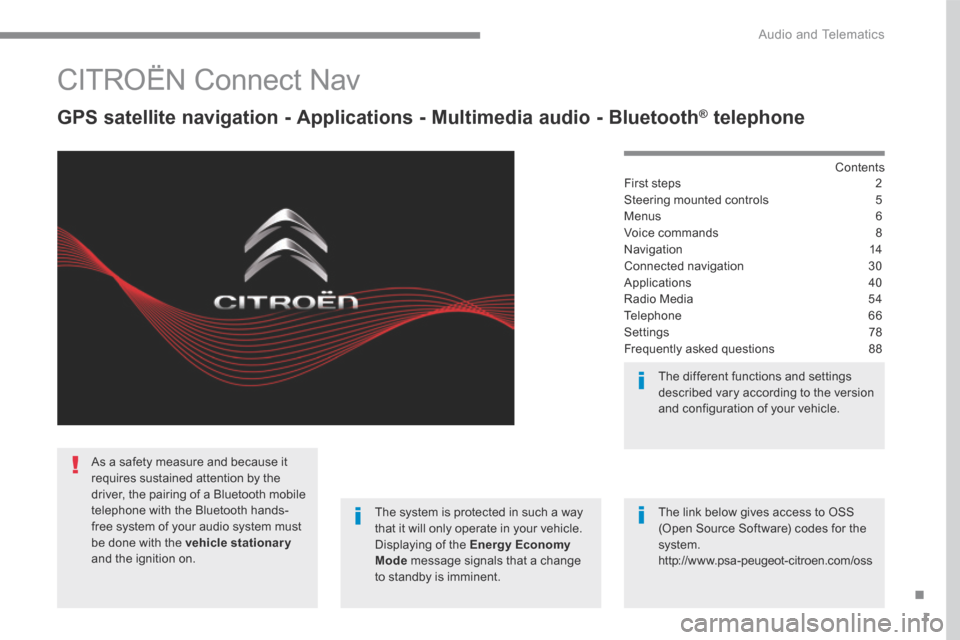
1
.
Audio and Telematics
CITROËN Connect Nav
GPS satellite navigation - Applications - Multimedia audio - Bluetooth ® GPS satellite navigation - Applications - Multimedia audio - Bluetooth ® GPS satellite navigation - Applications - Multimedia audio - Bluetooth telephone ® telephone ®
Contents First steps 2
Steering mounted controls 5
Menus 6
Voice commands 8
Navigation 14
Connected navigation 30
Applications 40
Radio Media 54
Telephone 66
Settings 78
Frequently asked questions 88
The system is protected in such a way that it will only operate in your vehicle. Displaying of the Energy Economy Mode message signals that a change to standby is imminent.
The different functions and settings described vary according to the version and configuration of your vehicle.
The link below gives access to OSS (Open Source Software) codes for the system. http://www.psa-peugeot-citroen.com/oss
As a safety measure and because it requires sustained attention by the driver, the pairing of a Bluetooth mobile telephone with the Bluetooth hands-free system of your audio system must be done with the vehicle stationaryand the ignition on.